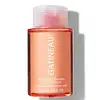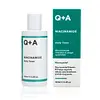What's inside
What's inside
 Key Ingredients
Key Ingredients

 Benefits
Benefits

 Concerns
Concerns

No concerns
 Ingredients Side-by-side
Ingredients Side-by-side

Water
Skin ConditioningPropanediol
SolventPentylene Glycol
Skin ConditioningGluconolactone
Skin ConditioningMethylpropanediol
SolventPolyglyceryl-10 Laurate
Skin ConditioningSodium Citrate
Buffering1,2-Hexanediol
Skin ConditioningSodium Hydroxide
BufferingSalicylic Acid
MaskingPolyglyceryl-4 Caprate
EmulsifyingCitric Acid
BufferingGlyceryl Caprylate
EmollientHydrolyzed Jojoba Esters
Skin ConditioningParfum
MaskingSodium Hyaluronate
HumectantTropaeolum Majus Flower/Leaf/Stem Extract
Skin ConditioningLimonene
PerfumingPotassium Sorbate
PreservativePhenoxyethanol
PreservativeHelianthus Annuus Seed Oil
EmollientTocopherol
AntioxidantEthylhexylglycerin
Skin ConditioningWater, Propanediol, Pentylene Glycol, Gluconolactone, Methylpropanediol, Polyglyceryl-10 Laurate, Sodium Citrate, 1,2-Hexanediol, Sodium Hydroxide, Salicylic Acid, Polyglyceryl-4 Caprate, Citric Acid, Glyceryl Caprylate, Hydrolyzed Jojoba Esters, Parfum, Sodium Hyaluronate, Tropaeolum Majus Flower/Leaf/Stem Extract, Limonene, Potassium Sorbate, Phenoxyethanol, Helianthus Annuus Seed Oil, Tocopherol, Ethylhexylglycerin
 Reviews
Reviews

Ingredients Explained
These ingredients are found in both products.
Ingredients higher up in an ingredient list are typically present in a larger amount.
Citric Acid is an alpha hydroxy acid (AHA) naturally found in citrus fruits like oranges, lemons, and limes.
Like other AHAs, citric acid can exfoliate skin by breaking down the bonds that hold dead skin cells together. This helps reveal smoother and brighter skin underneath.
However, this exfoliating effect only happens at high concentrations (20%) which can be hard to find in cosmetic products.
Due to this, citric acid is usually included in small amounts as a pH adjuster. This helps keep products slightly more acidic and compatible with skin's natural pH.
In skincare formulas, citric acid can:
While it can provide some skin benefits, research shows lactic acid and glycolic acid are generally more effective and less irritating exfoliants.
Most citric acid used in skincare today is made by fermenting sugars (usually from molasses). This synthetic version is identical to the natural citrus form but easier to stabilize and use in formulations.
Read more about some other popular AHA's here:
Learn more about Citric AcidPotassium Sorbate is a preservative used to prevent yeast and mold in products. It is commonly found in both cosmetic and food products.
This ingredient comes from potassium salt derived from sorbic acid. Sorbic acid is a natural antibiotic and effective against fungus.
Both potassium sorbate and sorbic acid can be found in baked goods, cheeses, dried meats, dried fruit, ice cream, pickles, wine, yogurt, and more.
You'll often find this ingredient used with other preservatives.
Learn more about Potassium SorbateSodium Hyaluronate is hyaluronic acid's salt form. It is commonly derived from the sodium salt of hyaluronic acid.
Like hyaluronic acid, it is great at holding water and acts as a humectant. This makes it a great skin hydrating ingredient.
Sodium Hyaluronate is naturally occurring in our bodies and is mostly found in eye fluid and joints.
These are some other common types of Hyaluronic Acid:
Learn more about Sodium HyaluronateWater. It's the most common cosmetic ingredient of all. You'll usually see it at the top of ingredient lists, meaning that it makes up the largest part of the product.
So why is it so popular? Water most often acts as a solvent - this means that it helps dissolve other ingredients into the formulation.
You'll also recognize water as that liquid we all need to stay alive. If you see this, drink a glass of water. Stay hydrated!
Learn more about Water